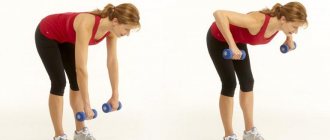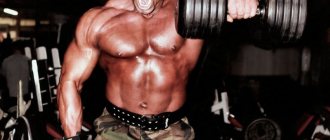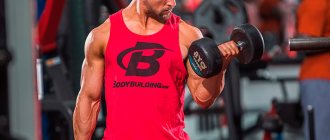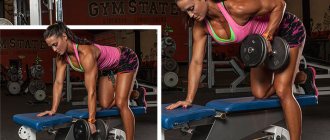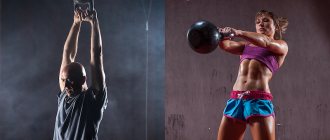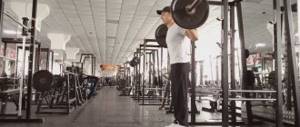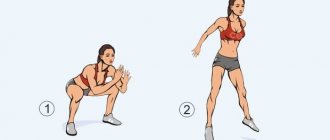Description of the exercise
The dumbbell seated shoulder press can be performed every day. To improve endurance performance, it is recommended to do it several times a week. The number of approaches should be 5 x 25 times with weight. When selecting the right weight, it is important that it does not cause fatigue in the athlete during training. For those who do not have sufficient shoulder strength, this technique should be performed through burning.
What muscles work
When pressing dumbbells while sitting, which muscles work? The main load falls on the anterior and lateral bundles of the deltoid muscles. Also involved in the training are the triceps, latissimus dorsi, trapezius, wrist flexors, pectoralis major and serratus anterior.
Benefit
Performing a technique such as the seated shoulder press allows the athlete to achieve good results by improving his own body. The athlete will receive:
- building muscle mass on the deltoid muscles;
- shoulder width growth;
- increasing strength indicators by combining exercises in different positions;
- external elimination of narrow shoulders and large buttocks.
Contraindications
Performing dumbbell overhead presses is contraindicated for people who have the following disorders:
- curvature in the thoracic region;
- hernias;
- protrusion of the spinal column;
- curvature in the lumbar region.
If such health problems are detected, it is worth abandoning the axial load on the spine. Work with the shoulders should be performed with arms abducted with dumbbells to the sides.
Execution technique
You can perform the bench press in one version, or even combine several in one workout, but in this case, distribute the number of repetitions and approaches equally.
Classical
Execution steps:
- Place dumbbells in both hands and spread your elbows to the sides.
- Sit up straight and bend your lower back slightly forward.
- Straighten your shoulders and squeeze your shoulder blades together.
- Taking the exercise machines in both hands, spread them so that they are at shoulder level.
- As you exhale, raise your hands up and touch each other at the top point.
- Lower your hands to ear level.
In the classic version, the palms should be correctly placed as if the person performing the exercise was holding the barbell with them. When performing the exercise, the elbows should only move along the vertical axis.
If you lower the dumbbells below the back of your head, then the upper part of the trapezius works. To use it, lower the dumbbells as low as possible. If we are talking about pumping exclusively the deltoid muscles, then there is no need to lower the dumbbells below the back of the head.
With hands turned
Stages of performing a dumbbell press while sitting on a bench with your wrists turned:
- Sit up straight with your lower back slightly forward.
- Take dumbbells in both hands, point your elbows to the sides.
- Straighten your shoulders, and at this time your shoulder blades should be brought together.
- Hands at the lowest point should be turned with palms back.
- When lifting, your arms should gradually turn 180 degrees.
During this exercise, the main load falls on the front deltas.
In the simulator
Execution steps:
- Set the most suitable working weight on the machine.
- Sit in a chair and spread your legs to the sides.
- Place your feet on the floor.
- Grasp the handle of the exercise machine with your hands.
- Tighten your abs.
- First, inhale and then exhale, straighten your elbow joint and press your arms up.
- Stay at the top point for a short period of time.
- Slowly return to the starting position.
Interesting Facts
The seated dumbbell press with wrists turned is also called the Arnold press. It is not difficult to guess that this exercise is named in honor of the seven-time winner of the Mr. Olympia tournament, movie star, organizer of the Arnold Classic competition and politician Arnold Schwarzenegger.
This exercise wasn't invented by Iron Arnie himself, but he did make extensive use of the swing press, which helped him build some truly impressive shoulders.
This dumbbell press variation has been a critical component of many other athletes' training programs.
For example, in 1980, German bodybuilder Aniko Hermann attracted attention with his outstanding deltoids at the next competition. His shoulders were large and well defined.
When the competition ended, one of the judges asked Herman’s coach - he wanted to know how the bodybuilder made such big shoulders in just a year.
The answer was simple - the Arnold press and the correct regime. It was these two components in combination that provided the athlete with rapid growth in muscle mass.
The seated dumbbell press is perhaps the most popular exercise for working the front and middle deltas.
However, according to Norwegian scientists published in 2013, standing dumbbell presses are more effective.
The researchers used a method called electromyography, which can accurately measure the electrical activity of muscles during exercise.
As a result, they found that the standing press loads the front deltoids 8% more effectively, and the middle ones 24%.
Basic mistakes
When performing a bench press in a seated position, an athlete may make some mistakes that will cause ineffective training. The most common of them include:
- Excessively long workouts. When performing this technique, it should be taken into account that the shoulder muscles are involved when pressing the barbell, push-ups from the uneven bars and the floor. Following from this, you should not combine seated dumbbell and barbell bench presses on the same day. The same applies to any other exercises that put stress on the shoulder muscles. If you resist and do not follow this recommendation, this may cause the muscles to be “clogged” and ultimately damaged.
- The press was performed in a small amplitude. It is considered correct to perform the exercise when, in the initial position, the arms are bent in such a way that the weights are located at eye level, and at the top point they should be straightened. Similar conditions are necessary to fulfill for proper shoulder training. In order for the deltoid muscles to be well stretched, the weights should be lowered low enough.
- Spreading to the sides. When your hands with dumbbells are at the top point, they should be located close to each other, and they should be kept level. If you do not follow the specified exercise technique, you will not be able to achieve good results.
- Incorrect leg position. To ensure good performance of the target muscles, it is necessary to achieve a stable position when performing the approach. To do this, you need to spread your legs wide and place them on the floor.
- One-arm press. Performing this action is erroneous due to the fact that you can easily get a shoulder injury. If an athlete decides to pump only one deltoid, this may cause unilateral hypertrophy of the brachial muscle.
It is important
- Choose the appropriate weight.
- Do the exercise on a bench with a backrest, this will give maximum load to the target muscles. During the entire approach, maintain a slight arch in your lower back.
- Spread your legs wide, placing them firmly on the floor: this will provide you with reliable support and allow you to concentrate on working your shoulders.
- Monitor the correct trajectory of raising and lowering the dumbbells and the range of movement.
- Don't forget to breathe correctly: exhale powerfully while lifting the dumbbells and take a deep breath when lowering them.
- Pay special attention to the negative phase of the movement - then your shoulders will grow as quickly as possible.
- While performing the exercise, mentally concentrate on the work of the deltoid muscles - this will allow you to work them out really well.
Tips and tricks
These recommendations will help you avoid unwanted consequences and improve the effectiveness of your training:
- You can ask for help from a coach or a more experienced athlete to supervise the exercise, as it is important that the overhead press is correct.
- When working with heavy weights, it is recommended to use an athletic belt.
- There is no need to push your elbows forward when performing the exercise, and you should not bend over or arch your back.
- During the execution of the technique, all movements should be carried out at a moderate pace. If you do the exercise with sudden movements, this can cause an injury to your elbow.
- When performing the exercise, you do not need to turn your hands. The press itself should be performed in such a way as if instead of dumbbells the athlete had a barbell in his hands.
- There is no need to lower your arms too low, as this will reduce the strength potential of the deltoid muscles.
Weight selection
Choosing the right weight is a key factor affecting the effectiveness of the exercise performed. If the weight is too light, the effect of training will be minimal. If it is difficult to solve this issue on your own, then you can seek help from a more experienced athlete or coach.
Suitable weight is the main task that an athlete must cope with. It is recommended to select dumbbells so that the press itself is difficult to perform 8 times, and the next lift the athlete is unable to perform it, relying only on his own strength.
Strength or volume?
On the one hand, the shoulders must be strong. On the other hand, pumped up shoulders look very beautiful. Which is better - strength or volume - is a controversial question.
You also need to have a strong shoulder. To do some work overhead, to hold something for a long time, and the like. Only strength in this case is not enough.
It really all depends on the sport. In tennis, team sports, rowing and other sports that require muscular endurance and joint health, strength is typically developed in the off-season and the competition mode is used during the competitive period.
In bodybuilding, they either work with weight-and-cut cycles, or they simply perform exercises for the number of repetitions in a maintenance mode that is optimal for a particular athlete's recovery.
For normal life, you need a moderate combination of joint mobility, muscular endurance and strength. The fact is that holding a scale above your head, lifting objects, and even just keeping your hand on a handrail while transporting requires a combination of strength and endurance.
Important : shoulder muscle training should combine elements of strength and endurance. There is no universal dial repetition mode for everyone. Some athletes start out with more strength, while others have more endurance.
Example of a training program with exercise
Training program for general development of the shoulder muscles:
- Dumbbell sitting shoulder press - 3 x 10.
- Raising arms with dumbbells to the sides in a standing position - 3 to 10.
- Raises with dumbbells in support - 3 to 12.
- Front barbell overhead press - 2 to 12.
- Shrugs with a barbell - 3 to 10.



